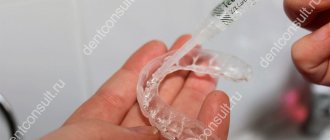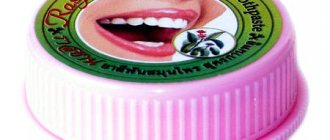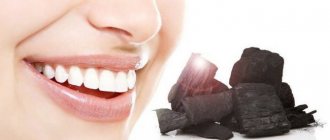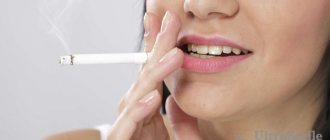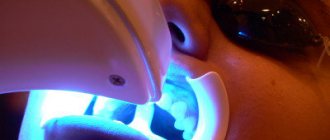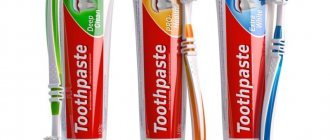It is difficult to overestimate the impact of teeth on a person’s life. In addition to their functional significance, teeth also play a big role in how others perceive us. Yellow, caries-affected, decayed or crooked teeth do not add to the attractiveness, but healthy, clean, white and beautiful teeth are associated (and not unreasonably) with good health of the whole body.
Many people strive for a perfect smile and therefore rush to use whitening toothpastes, presented in all their variety on the market today. But are they really that effective and can they replace professional cleaning? And is it possible to use whitening toothpastes permanently?
How does toothpaste whiten?
Today, aesthetic dentistry divides whitening pastes into three types, which differ in the principle of their effect on the tooth surface:
Mechanical impact
All toothpastes contain various abrasives, but whitening toothpastes contain larger abrasive particles. They act on the enamel like a scrub, mechanically removing yellow surface plaque, and also intensively polish the teeth. But an increase in abrasiveness also means that there is a high probability of injury to the enamel along with the gums. Therefore, regular use of such pastes can lead to hyperesthesia - increased tooth sensitivity.
Chemical exposure
In order to achieve a whitening effect, low-percentage solutions of hydrogen peroxide or urea are added to the paste. Active enzymes of the substance interact with yellow plaque, oxidizing pigments and thereby making teeth a little lighter. In addition to peroxide, whitening toothpastes may contain chemical ingredients that lighten teeth by removing stained pellicle (a thin organic film covering tooth enamel).
Preventive effects
Often, the category of whitening pastes includes products aimed at preventing the formation of dental plaque. Various crystallization inhibitors prevent the mineralization of soft yellow plaque and tartar. Such pastes are especially relevant for smokers and coffee lovers. But it should be remembered that their use makes sense only after professional hygienic teeth cleaning in the clinic.
Popular products for sensitive enamel and gums
What should those who have gum problems, such as bleeding, do? The best solution is to contact a dentist, who will select the optimal products. But you can also purchase the most gentle and safe formulations that promise to lighten and strengthen the enamel, as well as anti-inflammatory therapy for the gums.
This is interesting! According to [1] some studies, people’s choice in favor of a particular paste in 36% of cases is based on reviews from social networks, in 32% on advertising. About 32% of respondents pay attention to packaging design and only 12% of patients follow the recommendations of their doctor.
There are many options: Parodontax “Comprehensive Protection”, Dentissimo Gold Advanced Whitening, ROCS Sensitive, Medical Minerals or “Active Calcium”, Miradent Mirawhite gelee, Himalaya Herbals Sparkly White, Crest Pro-Health Sensitive, Vitex Black clean “Whitening + Gum Protection” , Biorepair Pro White, Asepta Plus “Gentle Whitening”, Natura Siberica “Pearl of Siberia”, Sensodyne F.
The listed products contain natural and herbal ingredients, fruit and mint extracts, pharmaceutical herbs (for example, chamomile).
Do whitening toothpastes whiten?
There is a clear answer to this question - no, if by teeth whitening we mean a change in their color. You should not believe numerous commercials in which manufacturers promise instant results after using whitening pastes. The most they can do is return the teeth to their natural shade by removing or lightening the yellow plaque that has accumulated on their surface. Thus, there is a slight change in color, but not as a result of bleaching, but rather of cleansing. But you can really whiten your teeth only with the help of professional photo whitening, laser whitening or home whitening with a tray. After this, it makes sense to use whitening toothpaste to maintain the results.
An effect worth counting on
A whitening paste that you purchase at a pharmacy or store can promise to lighten your enamel by up to 3-4 or even 5 tones. However, dentists believe that these are just marketing tricks to attract more customers. In fact, even the best samples, which contain peroxides, can make hard tissues lighter by only 2 shades. The maximum effect that can be expected from abrasives is 1 tone.
It is also very important to take into account this point: if the enamel is yellowish, and the yellowness is associated with plaque and the food consumed, then the use of bleaches will really help it become lighter. If the teeth are dark in color, have a thick layer of plaque on them, very bright pigment and various stains, and this is the result of internal rather than external factors (for example, disease), then it will definitely not be possible to get rid of the defect using home methods. In case of these problems, it is recommended to immediately consult a doctor, who will offer to restore the aesthetics of the smile in other ways, for example, prosthetics, artistic restoration.
Important! The effect of using the products is unstable. Within a month after stopping use, the color of the teeth becomes the same.
Who needs whitening toothpaste?
Who is recommended to whiten teeth using special toothpastes? First of all, coffee lovers and smokers, since nicotine and caffeine stain teeth an unpleasant yellow color. Whitening pastes are also suitable for those who have undergone professional teeth whitening and want to maintain the effect for a long time. If you do not belong to any of the listed categories and still want to experience the effects of a toothpaste labeled white, think carefully. For example, such pastes cannot be used for hypersensitive teeth, wedge-shaped defects, gum and periodontal diseases, as well as for children under 12 years of age and pregnant women.
Alternative option
The most effective way to whiten your teeth is to choose the option of professional teeth cleaning, discussing with your dentist all the features and effects of the procedure. These types of cleanses provide more noticeable, faster and longer-lasting results. The procedure generally takes about an hour, depending on the condition of the teeth. In addition, professional teeth cleaning is also useful in preventing caries, because By removing the stains, it will be easier to detect the initial stages of caries. In any case, consulting a dentist is the best way to solve any problems related to the color and health of your teeth, and to find the right solution to these problems.
How to choose the best whitening toothpaste?
When choosing a toothpaste, there are several points to pay attention to. First of all, familiarize yourself with the composition of the toothpaste. It should not contain substances with an abrasiveness greater than 25 RDA, especially titanium dioxide. If the paste contains hydrogen peroxide, make sure it does not exceed the permissible limit of 0.1%. Read the instructions for use carefully. Do not forget that toothpaste with a whitening effect cannot be used constantly. Manufacturers may recommend the use of whitening paste in courses of 30–60 days, either twice a week or in another mode.
Most Russian dentists do not recommend their patients to use whitening pastes, as they believe that they contain substances that can have a negative effect on tooth enamel. Are they right? Yes and no. Using whitening pastes if there are contraindications, as well as their uncontrolled use, will really not bring anything good. But if you use such pastes correctly, according to the recommendations and indications, they will not cause harm and will help make your smile, if not brighter, then more attractive. To remove the effect of tooth sensitivity, also use toothpastes with fluoride.
Rating of popular products with abrasive particles
Some people believe that the best whitening toothpaste is one that contains polishing solids or microbeads. The number of such particles is usually indicated on the packaging by the abbreviation RDA (Relative Dentin Abrasivity - abrasivity index adopted by the American Dental Association). We emphasize that almost all pastes contain abrasives, just in different quantities:
- 20-30 RDA: this index can be assigned to therapeutic and prophylactic, but also to whitening paste for sensitive teeth,
- 30-50 RDA: suitable for children,
- 70-80 RDA: can be used on an ongoing basis for quite a long time. For example, 1-2 months in a row,
- 80-100 RDA: products that can make the enamel lighter by 1 tone. Can only be used after consultation with a dentist. Cannot be used continuously. After use, it is better to switch to remineralizing compounds,
- 120-200 RDA: This is the maximum allowable level of abrasiveness with which you can achieve a 2-tone effect. Only people with healthy teeth and gums are allowed to use it. They are used in courses with long breaks. For example, once a week.
Which whitening toothpaste is best? We have compiled a small rating based on consumer opinions.
PresiDENT
These are Italian-made toothpastes of decent quality. Many people also note that the manufacturer offers a wide range of products for every occasion.
| Variety PresiDENT | Description | Price |
| White |
| From 250 rubles |
| Smokers |
| From 250 rubles |
| White Plus |
| From 200 rubles |
| Renome |
| From 280 rubles |
Blend-a-med White 3D
Despite the fact that the manufacturer does not indicate the abrasiveness index, the product is very popular among consumers. This may be due to the fact that Blend-a-med White Luxe 3D is available in different designs and modifications: “Glamour”, “Delicate Whitening”, “Invigorating Freshness”, “Enamel Protection”. That is, each person will be able to choose exactly the option that he likes. In addition, it has a decent fluoride content of 1450 ppm, and this guarantees the strengthening and protection of the enamel from negative effects.
Dentists believe that the composition of all varieties of Blend-a-med White Luxe 3D is almost the same. Buyers are pleased with the quite budget price - from 200 rubles.
ROCS
How to choose a whitening toothpaste among the variety of products presented? Carefully read the information on the packaging and pay attention to the composition. The ROCS brand has prepared a varied selection for its customers:
- “Sensational whitening”: there is a very high amount of solid granules that help remove plaque - 139 RDA. As for fluoride, it is absent, but there is calcium glycerophosphate, which strengthens hard tissues no worse, and also polishes them to a shine,
- “Delicate whitening” with sweet mint: perfectly freshens breath. This includes a special mineral complex Enzime and Minerals, which prevents the development of caries and inflammatory processes in periodontal tissues,
- “Restoration and whitening” from the Sensitive series: without fluorine and polishing particles. Suitable for sensitive fabrics. Contains calcium hydroxyapatite, xylitol and magnesium,
- “Coffee and Tobacco”: suitable for everyone who has bad and not so bad habits. Effectively removes pigmented plaque, has an antibacterial effect, strengthens enamel due to incoming fluoride, relieves signs of inflammation on the mucous membrane,
- Pro Brackets & Ortho: A good option for maintaining the natural whiteness of enamel for those undergoing orthodontic treatment with braces.
Products from ROCS are in an affordable price segment - from 200 rubles.
Colgate Optical White
Many people prefer to use Colgate brand products, despite the lack of information about the abrasiveness index and the poor quality of the composition. What is the reason for such popularity? According to dentists, large-scale advertising of this brand and low cost - from 200 rubles - play a role here.
What can you say about this product? It contains fluorine in an amount of 1000 ppm, silicon dioxide and optical components that create a reflective film on the surface of the teeth. While you are using the product, you notice how the enamel shines and even becomes lighter, but immediately after stopping use the effect disappears.
LACALUT White
Here, the optimal content of abrasives and tooth-strengthening fluoride is 120 RDA and 1357 ppm. The manufacturer claims that the polishing microgranules have rounded edges, which prevents damage to hard tissues and promotes gentle and gentle cleaning. True, the composition contains methylparabens, which is very important for people with sensitive gums and those prone to allergic reactions to know.
The purchase price will be about 300 rubles.
SPLAT
In general, many SPLAT brand products contain the “SpWhite System BIO” formula, which promotes gentle plaque removal and enamel polishing, while providing an anti-inflammatory and antiseptic effect, strengthening hard tissues due to various natural components: tropical plant extracts, bromelain, calcium glycerophosphate, fluorine.
Adherents of this brand can recommend SPLAT Professional “Whitening Plus”, Special Dream for sensitive enamel with calcium hydroxyapatite, Blackwood and Black Lotus with charcoal. Price – from 200 rubles.
REMBRANDT Intense Stain
Professional bleaches such as REMBRANDT are not cheap - about 1,500 rubles per tube. But they can boast of a clearly proven safe composition and effectiveness. The product contains few abrasives - 85 RDA, but there is a good concentration of fluoride to fully strengthen teeth - 1500 ppm. Recommended for smokers, as well as people who abuse foods and drinks with coloring pigments.
Detartrine Z
Judging by the reviews, this expensive French-made product (1,400 rubles per tube) can cope not only with soft pigmented, but also partially mineralized plaque.
Crest 3D White brilliance
This is not a budget product. Price – about 800 rubles. However, consumers assure that Crest products are worth the money, because after its use, a protective three-dimensional film is formed on the enamel, which literally repels color pigment and also prevents plaque from catching, so teeth remain white longer.
Weleda
Here, according to the manufacturer, the composition is completely natural. Sea salt plays the role of an abrasive, which not only perfectly removes soft plaque, but also has an anti-inflammatory and antiseptic effect. In addition, Weleda increases salivation, and as you know, saliva cleanses the oral cavity of plaque and has protective properties. Price – from 300 rubles.
On a note! People considering the most budget-friendly, but at the same time relatively safe options can purchase Biomed White Complex - from 120 rubles, SILCA Arctic White - from 80 rubles, "New Pearl - Whitening" - from 60 rubles.
1/ Coconut oil
It's no secret what an amazing effect coconut oil can have on your hair and skin, but few people know that this product is equally beneficial for your teeth and can help you achieve a snow-white smile. Oil pulling has long established itself as an effective hygienic procedure that came to us from Ayurveda. Coconut oil's whitening power was confirmed by a 2015 study that found a "statistically significant reduction in plaque" after seven days of oil pulling.
No wonder this procedure has earned its recognition among celebrities: Gwyneth Paltrow, Nicole Richie and Shailene Woodley start each day with 20 minutes devoted to caring for their teeth and gums. Tatyana Korsakova is also a big fan of this procedure: oil pulling has no contraindications and can be part of a daily dental and oral care routine.
5/ Rinse your mouth after meals
The most inexpensive and easiest way to protect your teeth from darkening is to rinse your mouth after every meal. Most products do not affect the color of the enamel, but if we are talking about the main enemies of a pearly smile, then they are well known. These are cigarettes, red wine, tea, coffee, dark soda. Rinsing your mouth thoroughly after eating helps wash away some of the coloring agents, as well as food and sugar residues.
Overall, this procedure is very important for oral hygiene: it maintains the correct pH balance, minimizing the growth of bacteria, and increases the body's protective properties. By analogy with oil pulling, rinsing the mouth after eating is called water pulling in Ayurveda.
The possibilities of modern dentistry are almost limitless. By contacting a specialist with the problem of insufficiently white teeth, you can get solutions for every taste and budget. However, many of the techniques often damage the enamel and make teeth more sensitive. That is why we advise you to resort to traditional means, the effectiveness of which has been proven for more than one generation.
How to whiten a smoker's teeth at home
Interestingly, according to statistics, not only women, but also men prefer to whiten their teeth at home. This is especially true for smokers, whose teeth acquire an extremely unhealthy yellow tint as the “experience” of their addiction increases. Alas, no “miracle recipe” from the Internet can cope with this problem.
Smokers accumulate tar deposits on their teeth, which require serious efforts to remove, so home systems, and especially folk remedies, will be ineffective. Only professional whitening systems are suitable for this category: laser and Zoom. However, if a person continues to smoke after this, his “natural” teeth color will quickly return. If you want to get long-term results, you will have to give up cigarettes.
What can you eat
List of healthy permitted foods:
- cottage cheese, milk, low-fat sour cream, yogurt without additives;
- cucumbers, cabbage, potatoes, asparagus, celery;
- green grapes, pears, peeled apples, bananas;
- unleavened cheese;
- clear broth;
- white lean meat;
- seafood;
- white fish;
- mushrooms;
- some types of nuts;
- egg white;
- oatmeal, buckwheat and rice porridge;
- bread;
- pasta without sauce;
- water, clear fruit compote.
Even after 48 hours, experts recommend drinking weak green tea through a straw.
Save the result
Now that your teeth are clean, it's time to think about how to strengthen and maintain their whiteness for a long time. There are a few simple rules to follow after whitening.
What you need to do to make the whitening results last longer:
- carry out high-quality brushing of teeth at least 2 times a day;
- carefully remove food debris, brush your teeth with floss or brushes;
- prevent the accumulation of plaque and bacteria in the mouth;
- try to quit smoking, because nicotine darkens your teeth;
- After tea and coffee, be sure to brush your tooth enamel;
- regularly treat dental diseases.
Any whitening procedure quickly gives the desired result, but this is only a temporary effect. Constantly whitening your teeth is not an option, because this procedure will gradually destroy them. In order for the enamel to retain its natural whiteness for a long time, it must be carefully taken care of. Try to visit the dentist twice a year and do not overuse at-home whitening.
Excursion into history
The desire to slay everyone with your snow-white smile has not been alien to people for many centuries. The ancient Egyptians, Romans and Greeks attached great importance to personal hygiene. Smooth and beautiful teeth were then considered an indicator of wealth and good form. Ancient ancestors used crushed eggshells, ash, powdered stones as a paste, and even rubbed their teeth with onions, which gave the enamel a pearly shine. In Medieval Europe, things were completely different. Ladies in crinolines and knights in armor lived in an atmosphere of stench, and white teeth were even called a sign of low origin.
An extremely incomprehensible manipulation for modern man, which was resorted to by people of different times and nations, was the blackening of teeth. In Japan, this custom, widespread until the end of the 19th century, was called “ohaguro”. Black varnish on the teeth was considered a sign of beauty and supposedly compensated for iron deficiency. The durability of a married woman's charcoal-colored enamel was even compared to her fidelity to her husband. Among the wealthy strata of the Russian population, black teeth were also not uncommon. Frequent consumption of sugar, which was a fairly expensive commodity, led to tooth decay, which was an indirect proof of wealth.
Marlene Dietrich
